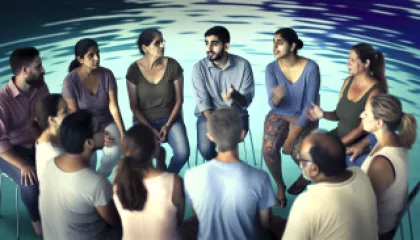The Ultimate Guide to Sensory Processing and Relaxation
Welcome to The Ultimate Guide to Sensory Processing and Relaxation! In this comprehensive guide, we will explore the fascinating world of sensory processing and its connection to relaxation. Whether you are a parent looking to support your child's sensory needs or an adult seeking strategies for self-care, this guide has got you covered.
Section 1: Understanding Sensory Processing
Sensory processing refers to how our nervous system receives and interprets sensory information from our environment. It involves the way we process stimuli such as touch, taste, smell, sight, and sound. For most individuals, sensory processing occurs seamlessly, allowing them to navigate their surroundings effortlessly. However, some people may experience challenges in sensory processing, which can impact their daily lives.
1.1 What is Sensory Processing Disorder?
Sensory Processing Disorder (SPD) is a condition where individuals have difficulty organizing and responding to sensory information. People with SPD may be over-responsive, under-responsive, or have sensory-seeking behaviors. This can lead to difficulties in regulating emotions, attention, and behavior.
SPD can affect individuals of all ages, and it is often diagnosed in childhood. However, many adults also experience sensory processing challenges without a formal diagnosis. Understanding sensory processing and its impact is crucial for providing appropriate support and accommodations.
1.2 The Eight Senses
While most of us are familiar with the five traditional senses, sensory processing goes beyond that. There are actually eight senses that contribute to our overall sensory experiences:
- Visual Sense: The sense of sight, including color, movement, and depth perception.
- Auditory Sense: The sense of hearing and interpreting sound.
- Tactile Sense: The sense of touch and pressure on the skin.
- Olfactory Sense: The sense of smell and detecting different odors.
- Gustatory Sense: The sense of taste and experiencing different flavors.
- Vestibular Sense: The sense of balance and spatial orientation.
- Proprioceptive Sense: The sense of body awareness and position.
- Interoceptive Sense: The sense of internal bodily sensations, such as hunger, thirst, and pain.
Understanding these senses and how they contribute to our experiences can help us better address sensory processing difficulties.
Section 2: Strategies for Sensory Processing and Relaxation
Now that we have a foundational understanding of sensory processing, let's explore various strategies and tools that can promote relaxation and support individuals with sensory processing challenges.
2.1 Sensory Diets
A sensory diet is a personalized plan of activities and strategies designed to meet an individual's sensory needs. Just like a balanced diet nourishes our bodies, a sensory diet nourishes our sensory system. It typically includes activities that provide sensory input in a regulated and structured manner.
Sensory diets can be tailored to the specific sensory needs of each individual. They may include activities such as swinging, deep pressure touch, music therapy, aromatherapy, and more. Consulting with an occupational therapist experienced in sensory processing can help create an effective sensory diet.
2.2 Deep Pressure Techniques
Deep pressure techniques involve applying firm and even pressure to the body, which can have a calming effect on the nervous system. These techniques can be particularly beneficial for individuals who are over-responsive to sensory stimuli.
Some common deep pressure techniques include:
- Weighted blankets or vests
- Squeezing a stress ball or using therapy putty
- Compression garments or wraps
- Deep pressure massage
Using deep pressure techniques can help promote relaxation and reduce anxiety in individuals with sensory processing challenges.
2.3 Sensory-Friendly Environments
Creating sensory-friendly environments can significantly impact an individual's comfort and well-being. A sensory-friendly environment takes into account the specific sensory needs of individuals and minimizes sensory overload.
Here are some tips for creating a sensory-friendly environment:
- Provide a quiet space for relaxation and downtime.
- Use soft lighting or dimmers to control brightness.
- Minimize clutter and visual distractions.
- Offer noise-canceling headphones or earplugs.
- Create designated areas for different activities to minimize sensory confusion.
By adapting the environment to suit individual sensory needs, it becomes easier to relax and engage in daily activities more comfortably.
2.4 Mindfulness and Breathing Exercises
Mindfulness and breathing exercises are powerful tools for promoting relaxation and self-regulation. They can be especially beneficial for individuals with sensory processing challenges, as they provide an opportunity to focus attention and calm the nervous system.
Simple mindfulness exercises, such as mindful breathing or body scans, can help individuals become more aware of their sensory experiences and cultivate a sense of calmness. Deep breathing exercises, like diaphragmatic breathing or square breathing, can also promote relaxation by activating the body's natural relaxation response.
2.5 Sensory Processing Coaching
Sensory processing coaching involves working with a trained professional who specializes in sensory processing challenges. These coaches provide guidance, support, and personalized strategies to help individuals with sensory processing difficulties navigate their daily lives more effectively.
A sensory processing coach can assist in identifying triggers, developing coping mechanisms, and implementing sensory integration techniques. They can also collaborate with other professionals, such as occupational therapists, to create comprehensive support plans.
Section 3: The Benefits of Sensory Processing and Relaxation
Understanding the benefits of sensory processing and relaxation can provide motivation and encouragement for incorporating these practices into our daily lives.
3.1 Improved Self-Regulation
Engaging in sensory processing activities and relaxation techniques can enhance self-regulation skills. By learning to recognize and respond to sensory input effectively, individuals can better manage their emotions, attention, and behavior.
3.2 Reduced Anxiety and Stress
Sensory processing challenges can often lead to increased anxiety and stress. By incorporating relaxation strategies, individuals can reduce these negative emotions and experience a greater sense of calmness and well-being.
3.3 Enhanced Focus and Concentration
When sensory needs are met, individuals can focus and concentrate more effectively. By incorporating sensory processing strategies into daily routines, individuals can optimize their ability to engage in tasks and activities.
3.4 Improved Quality of Life
By addressing sensory processing challenges and promoting relaxation, individuals can experience an improved quality of life. They can engage in activities they enjoy, form meaningful relationships, and navigate their environments with greater ease.
Section 4: Conclusion
Congratulations on completing The Ultimate Guide to Sensory Processing and Relaxation! We have explored the fundamentals of sensory processing, strategies for promoting relaxation, and the benefits of incorporating these practices into our lives.
Remember, sensory processing challenges are unique to each individual, and it may take time to find the most effective strategies for yourself or your loved ones. Be patient, seek professional guidance when needed, and celebrate the progress made along the way.
By understanding and supporting sensory processing needs, we can create a more inclusive and supportive environment for individuals of all ages.






